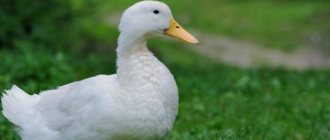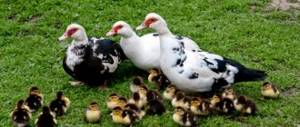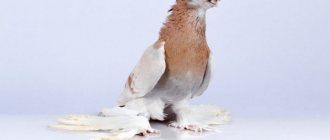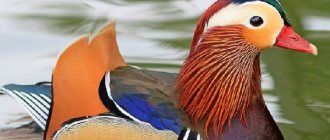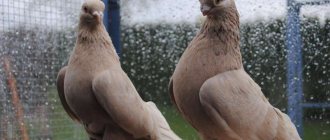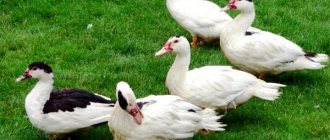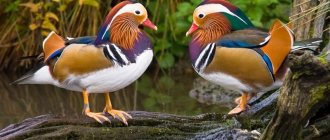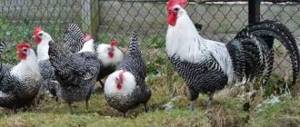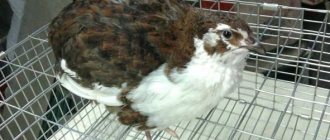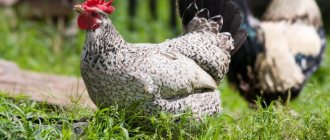- Wild animals
- >>
- Birds
The Cayuga duck is a medium-sized breed of domestic duck originating from the United States. It was developed in the mid-nineteenth century and was a very popular breed. The breed is named after Cayuga Lake, which is located in western New York. According to the American Livestock Conservation Service, these ducks are classified as "threatened," although their popularity is rapidly growing.
Origin of the species and description
Photo: Cayuga duck
There is a long history of this breed. The Cayuga duck is believed to have been developed from a cross between the Black East Indian duck and the Rouen duck. The Cayuga duck breed originated from a pair of wild ducks that a miller in Duchess County, New York, caught on his mill pond in 1809. But this account is historically inaccurate and is actually a count of the Gadwall duck. Historical opinion in New York is that the cayuga descended from the region's wild duck population, but no concrete evidence has been found in modern times to support the hypothesis.
Video: Cayuga duck
Another account of the origin of the Cayuga duck breed indicates that the Cayuga resembles (or was identical to) the English black duck breed often found in Lancashire, and was descended from this species. It is noted that the English black duck has since disappeared from Lancashire, having been replaced by the Aylesbury duck in the 1880s. By 1874, the Cayuga duck was accepted into the American Poultry Association's standard of excellence. The breed was raised in large numbers on duck farms in New York until the 1890s, when the Peking duck came to dominate the duck market in large cities.
Today, this breed of duck is very popular in the United States, they are mainly used for meat and eggs, and as pet ornamental birds. The Cayuga duck breed first appeared in the United Kingdom in 1851 when it was shown at the Great Exhibition at Crystal Palace and was recognized as the British standard in 1907. The Cayuga duck was accepted into the American Poultry Association's Standard of Perfection in 1874.
Origin of the Mulards
These poultry are the result of experiments by French breeders. The breed appeared by crossing the Muscovy duck and the White Peking duck. Birds were first bred in the 60s of the last century, and since then have been in demand in agriculture.
Close relatives of the breed are not found in the wild, since the homeland of the White Peking duck is Eurasia, and the Indian duck is South America. The area of distribution of Mulards is agriculture of different continents, including the territories of Russia.
From their parents, ducks received the best generic characteristics: from Peking ducks - large sizes, from Indo ducks - tender, dietary meat. Mularda hybrids do not naturally produce offspring; humans participate in replenishing the family.
Mularda ducks
Mulards have tender and dietary meat
Mulardy ducklings
Appearance and features
Photo: What a Cayuga duck looks like
The Cayuga duck is a medium-sized bird. It is easily characterized by its black beak and black plumage, which is an iridescent green color in the right light. Females develop white spots on their feathers in their second and subsequent years. Ducks are amazing to see in the sun. The legs and beak of cayuga ducks are black. They usually carry themselves in an upright position with a long neck. They have dark brown eyes and Cayuga ducklings have black plumage. The average body weight of a drake is about 3.6 kg, while ducks weigh on average about 3.2 kg.
One of the reasons ducks can stay afloat in water is because of the air sacs in their bodies that increase their buoyancy. Cayuga ducks' feathers trap air between them, which is another adaptation that helps them swim. Their feathers are also coated with a waterproof substance that keeps the ducks warm and dry. Ducks' webbed feet allow them to maneuver easily in the water.
Many ducks are excellent aviators thanks to their streamlined bodies, powerful wings, and hollow bones that weigh much less than the solid bones of mammals. Although Cayuga ducks are poor fliers due to their large, heavy bodies, they do have the strong wings and hollow bones that are common to other types of ducks.
Fun Fact: Cayuga ducks do not have teeth, but they do have jagged edges on their beaks that help them filter food from the water. The food is then swallowed and ground into a part of the stomach that contains small stones to break down the food.
Now you know what a Cayuga duck looks like. Let's see where this bird lives.
Possible diseases
Many owners praise musk ducks for their fairly strong innate immunity, but in nature there are no living organisms that are completely invulnerable to any disease. Indian ducks are no exception, therefore they fight some problems with preventive measures, while others are solved as they arise. It is worth considering what most often threatens the livestock and how to deal with it.
Of the external parasites, down-eaters are considered the most unpleasant enemy. These creatures look like small insects, whose length ranges from 1 to 5 millimeters. As the name suggests, the pest feeds on the down and feathers of birds, but it also does not disdain the top layer of skin and even blood if open wounds appear on the body of the individual. Naturally, the presence of such unwanted guests is extremely uncomfortable for the bird, which is why it constantly behaves restlessly, goes bald in places, and under such stress, of course, does not gain weight or lay eggs very well.
The natural method is quite effective, so the farmer’s task is only to provide the necessary conditions, as well as to further increase the efficiency - for this purpose, a package of purified food sulfur is mixed with the sand. All that is needed is to generously sprinkle the livestock with the resulting mixture, and also provide the Indian ducks with a separate trough with it, where additional “bathing” can be done.
Another common problem is goiter catarrh. The causes of the disease can be different - for example, the farmer fed the pets low-quality food, or the bird itself mistakenly tried to swallow something foreign. Because of this, the goiter swells (which is the main sign of the disease), blocking the airways, but with a lack of oxygen, the normal development of the body becomes impossible.
In addition to swelling, goiter catarrh can be identified by other characteristic signs. The bird feels as if something is stuck in its esophagus, so it behaves restlessly and often does not want to eat, even though according to the schedule it is high time for it to get hungry. In addition, there is a characteristic unpleasant odor from the mouth, which is not noted in healthy individuals.
If you manage to diagnose such an ailment, you need to try to immediately help the duck, even though it will resist. The sick animal must be turned upside down, held by the paws, and the swollen crop must be massaged - if something is really stuck there, such a procedure may help the “stray” food either fall out or end up in the stomach. Inflamed internal organs will inevitably cause pain with further feeding of hard foods, so it is advisable to transfer the affected individual to softer dairy foods.
Where does the Cayuga duck live?
Photo: Cayuga duck bird
The Cayuga duck is the only species of domestic duck that originated in the United States. Originally bred in upstate New York in the 1800s, the Cayuga duck later became popular throughout New England. But black Cayuga ducks, with green and blue feathers adorned with deep jewels, have fallen out of favor over the past 20 years due to commercialization of poultry and the duck's internal problems.
Domestic Cayuga ducks require shelter from wind and rain, access to food and water, and fencing to keep them contained. Cayuga ducks only require low fencing due to their limited flight ability. At the zoo, Cayuga ducks are kept on a pond surrounded by trees and bushes that serve as shelter for them.
Cayuga ducks need water to avoid getting sick from wet feathers when the cleaning iron dries out. Water also prevents them from getting pests such as ticks, fleas, lice, etc. Any birds kept in a flock should be kept hydrated. Although Cayuga ducks are not as prone to this as other birds, they should still have a routine to combat worms. Well-fed Cayuga ducks are unlikely to have any health problems.
Nutritional Features
As mentioned above, the cayuga is hardly a finicky bird. This thesis is also true in everything that concerns the nutrition of such ducks, which does not differ in any complexity. If we highlight those ingredients that are primarily recommended to be included in the diet of these birds, then their list is as follows:
- various greens;
- finely ground wheat and corn;
- mashes steamed with dairy products or meat broths.
Cayuga ducks need to add food of animal origin, namely insects, to their diet. As a rule, for this it is enough to simply give the birds the opportunity to regularly walk along the beds - in such cases they will easily find their “arthropod delicacies” on their own.
Provided that the cayuga eats well, it grows quite quickly: in just 2 months.
What does the Cayuga duck eat?
Photo: Cayuga duck in nature
Wild Cayuga ducks have a varied, omnivorous diet. While we think of them as eating mostly weeds, aquatic plants, and messing around in the dirt, you might be surprised to learn about some of the foods they eat.
While in the mud at the bottom of ponds and streams, they look for the following food items:
- crayfish;
- small shrimp;
- beetle larvae;
- small frogs;
- fish;
- triton.
They eat a lot of plant foods:
- seeds;
- greenery;
- weeds;
- aquatic plants;
- roots;
- grass;
- berries;
- nuts (in season).
Because their wildlife is unpredictable, Cayuga ducks have evolved to eat a variety of foods to maintain health throughout the year. Cayuga ducks can carry large reservoirs of fat under their feather insulation, which will feed them through short bursts of bad weather. They also reduce exposure to the elements by finding protected places to sit, and they have special blood flow to the legs and feet to prevent freezing.
Feeding Cayuga ducks the right diet has a huge impact on how they grow and develop. A poor diet and lack of nutrition will surely have a detrimental effect on them. Very few feed manufacturers make duck feed. You can use chicken feed instead. Chicken feed, although similar, does not provide all the necessary nutrients for Cayuga ducks, so you may have to improvise.
Features of cultivation
Cayuga has preserved the biological characteristics of wild ducks, so the main thing for them is free range and access to open water. In summer, it is necessary to fence the enclosure with a canopy. Under the canopy, the ground is covered with straw or boards, where the ducks will hide from the summer heat and rain. If there is no natural reservoir, place large, shallow containers of water. Grass must grow in the enclosure.
Duck Favorite - description of the breed
For overnight stays, a poultry house is set up with all the rules of sanitary requirements:
- the walls are freshly whitewashed with lime;
- temperature in winter is at least 6 degrees Celsius;
- it is necessary to ensure ventilation and ventilation of the room;
- the floors are covered with fresh sawdust or straw;
- there must be the required number of drinkers, feeders and nests.
Important! Ducks drink a lot, and the water often gets clogged, so the water in the drinkers is changed 2-3 times during the day. Cayugas tolerate low temperatures well; they can be released into an enclosure in winter, having first cleared the ground of snow and scattered straw over it. Cayugas tolerate low temperatures well; they can be released into an enclosure in winter, having first cleared the ground of snow and scattered straw over it.
Cayugas tolerate low temperatures well; they can be released into an enclosure in winter, having first cleared the ground of snow and scattered straw over it.
Reproduction
In hot climates, ducks retain the ability to reproduce throughout the year. In moderate conditions, eggs begin to be laid in March.
It is important not to miss this moment and indicate to the duck a place for laying, otherwise it will lay in inappropriate places and hide the clutch
Raising Cayuga ducklings is easy
Breeding Cayuga ducklings is not difficult: as soon as there are more than 10 eggs in the nest, the bird's hen instinct manifests itself. If this is not part of the owner's plans, the eggs must be periodically removed from the nest. If you plan to breed young animals, you can add eggs to the nest and leave them for incubation.
The development time of the embryos is 4 weeks, but the first ducklings begin to hatch 2-3 days earlier. Cayuga has a strongly developed maternal instinct, she takes good care of the chicks and, if the clutch is incubated by the female, she requires the main care. She needs to be fed on time and provided with walks for bathing and toileting.
If chicks are raised in an incubator, it is important to follow these rules:
- monitor the temperature - it should be 38 degrees Celsius;
- eggs are placed in the incubator with a sharp tip;
- turn the eggs according to the schedule;
- Cool the incubator four times a day for 10-12 minutes. turn off the heating.
Need to know! If you do not immediately pick up the hatched chick from under the hen, the duck will give up further incubation.
Feeding
The ducklings are fed 5 times a day with fortified foods:
- chopped boiled eggs, finely crushed shells;
- cottage cheese;
- kefir, milk mixed with porridge;
- nettles, dandelions and other greens;
- for good growth of chicks, mineral supplements and vitamins are added;
- feed is introduced into the diet after 3 weeks of age.
Important! Young Cayuga ducklings do not distinguish between edible food and pull everything into their beaks. Therefore, it is necessary to monitor the cleanliness of the feed. Feeding Cayug ducks is simple - the main part of it consists of a variety of greens, crushed wheat, corn and various cereal mashes, which are steamed in milk or water
For better stomach function, sand is added to the feed, and chalk is added to strengthen bones.
Feeding Cayug ducks is simple - the main part of it consists of a variety of greens, crushed wheat, corn and various cereal mashes, which are steamed in milk or water. To improve the functioning of the stomach, sand is added to the feed, and chalk is added to strengthen the bones.
The daily diet of poultry is:
- 10 days – 50 g;
- 20 days – 140 g;
- 30 days – 250 g;
- 40 days – 400 g;
- 50-60 days – 500 g.
Ducks are herbivorous birds and quickly gain body weight, even with a small amount of food. Among animal products, the Cayuga duck loves snails, caterpillars, and slugs. The bird gains weight sufficient for slaughter within 2 months. 5 days before slaughter, ducks are often given food. If ducks are not slaughtered, they can live up to 20 years.
Diseases
Cayuga is a type of duck that is resistant to many diseases. But if the sanitary condition of the premises is poor, from dirty water or poor-quality food, the following diseases can develop:
- hepatitis of viral origin - young ducklings get sick;
- coccidosis - adult ducks get sick, the infected bird is disposed of;
- aspergillosis is a dangerous fungal disease; the meat of a sick duck is unsuitable for food;
- salmonellosis;
- Avitaminosis, goiter disease - causes a lack of vitamins.
Cayuga is resistant to many diseases
Good nutrition and regular sanitation are the best prevention against duck diseases.
Features of character and lifestyle
Photo: Cayuga ducks
The Cayuga duck is docile in character and has a very good personality. This is one of the hardiest domestic ducks. They are easy to tame if you can catch them. They are very cold and hardy and can tolerate harsh winters in the Northeast. These birds are excellent feeders and get most of their diet from feeding, so they are very good for free-ranging. The breed is suitable for both meat and egg production.
Well-preserved cayugas can live longer than ten years, so the relationship you build with them will last a long time. As they age gracefully, cayugas begin to turn white with each molt, causing the mottled duck to appear as a shadow on the water. Their legs will also begin to take on an orange tint.
Fun fact: Cayuga ducks tend to stay close to home, and they are more likely to hatch eggs than other breeds because they sit on their eggs more often than other domestic ducks.
Cayuga ducks are quiet and beautiful ducks. They are unique because they have shiny green plumage. Cayuga eggs can be quite impressive in appearance, as the black color is transferred to the shell, but this is only a surface layer that is easily rubbed off. The degree of black coloration varies throughout the laying season—the eggs begin to darken early in the laying season and lighten as the season progresses. When you rub off the black cuticle, a green egg appears.
Breeding
Day-old young animals and hatching eggs can be purchased from trusted suppliers or from poultry farms engaged in breeding this breed of birds. An unverified buyer may sell a bird that, when later bred, will have splitting characteristics.
The fertilization of eggs is quite high. The gene pool is updated and inbreeding is not allowed. On average, ducks lay up to 150 eggs per year. An egg with a non-black shell color, with a greenish tint from older birds, is suitable for incubation.
Ducks can hatch eggs on their own, with an average of 15 ducklings per duck. They have a well-developed maternal instinct and take good care of the young. The incubation period is 26-28 days. Eggs from Cayuga ducks are collected for no more than 14 days and stored in a room with a temperature of up to 15 ° C. Placement into the incubator is done after the eggs have warmed to natural room temperature. After which the withdrawal can last up to 35 days. After the shells have hatched, it is necessary to allow the ducklings to dry, after which they are sent to a specially prepared place for their rearing or left under a hen, who is able to independently take care of the ducklings.
We can conclude that the bird is not only beautiful, but also productive. It can become a decoration for any farm and can provide the farmer with a good amount of meat and egg products.
Social structure and reproduction
Photo: Cayuga duck
Unlike other waterfowl such as swans and geese, Acayuga ducks do not mate once for their entire lives. Each seasonal relationship is monogamous, but most species choose a new partner at the beginning of the mating season in winter. Additionally, a much smaller number of Cayuga duck species—about 7%—practice polygamy. In this system, a male duck may mate with several females that inhabit his territory.
On average, a Cayuga duck can lay 100 to 150 large eggs per year. Their eggs are initially black or dark gray in color. But by the end of the season the color of the egg turns white. These ducks are quite loud. Cayuga ducks are hardy and can produce large numbers of offspring despite cold temperatures. They are wandering, often sitting and incubating eggs. The incubation period for cayuga duck eggs is 28 days. When using an incubator, the temperature should be 37.5°C with 86% humidity for 1-25 days and 37°C with 94% humidity for 26-28 days.
Fun Fact: The average lifespan of ducks kept as pets is 8 to 12 years.
Cayuga ducks live in groups. They lay eggs all year, usually starting in the spring, and will incubate the eggs if left sitting. The eggs are covered with a black or dark gray film that will wash off, although many birds now lay white eggs.
Breeding
The standard family composition is a drake and six to seven females. But it’s better if there are fewer ducks, then there are fewer scrambled eggs and the hatching of offspring is almost 100%. To preserve the herd, it is recommended to avoid inbreeding and regularly renew the blood.
Sexual maturity in females occurs at 8-9 months of age, in drakes - at 11 months.
Typically, ducklings are raised in an incubator to maintain the ducks' egg production. Ducks hatch up to 15 ducklings at a time, showing a strong maternal instinct when raising offspring.
Eggs for laying are collected for no more than two weeks and stored at a temperature no higher than 15 degrees. For incubation, the eggs chosen are not the dark ones carried by young females, but those from mature birds that are whitish, with a greenish tint. They are placed in the incubator after heating naturally to room temperature. The duration of the embryonic period is 26-28 days. When placed in an incubator, young animals can be hatched repeatedly. The fertilization rate of eggs is quite high.
Cayuga ducklings
If temperature and humidity deviate from the norm, hatching of young animals can take up to 35 days. Immediately after pecking, the ducklings dry out, after which they are sent to the brooder for a month or remain with the hen.
If the brooder is equipped with artificial lighting, the light is on around the clock for the first ten days. Lamps with red light are preferable - they preserve the chicks' vision. By two months, the light regime is brought to normal. At first, young animals grow faster at a temperature of 34-36 degrees, then within a month - 21 degrees.
In the first three weeks, the ducklings are fed starter feed for broiler chickens, then they are fed the usual formula. The scalded chopped grass is added. It is imperative to constantly have warm, clean water, which is changed 30 minutes after feeding or every couple of hours, so that pathogenic microorganisms do not enter the bird’s body.
Then the grown ducklings move into the poultry house, into a separate room. Young animals begin to be switched to adult food after fledging, at the age of one and a half months.
Thanks to their excellent productive qualities, unpretentiousness in maintenance, decorativeness and excellent character, American ducks have every chance of earning popularity in Russia and other countries of the post-Soviet space.
Natural enemies of cayuga ducks
Photo: What a Cayuga duck looks like
The biggest problem in caring for cayuga ducks is their predators. Cats, minks, weasels, raccoons and owls will eat ducks if given the opportunity. Cayugas should be brought into the building or tightly closed at night. A raccoon can kill and eat ducks through chicken wire, so the bottom of the fence should be lined with wire to protect them.
The Cayuga duck also needs protection from the hot sun. She should be provided with shade when the temperature reaches 21° Celsius. They love to swim, so a children's pool is enjoyable as long as the water is kept clean and the surrounding area is free of dirt. Ducks, however, can live well when given nothing but fresh drinking water.
The pool must be deep enough to cover their beak so that they can use it in cleaning their nostrils. The water should be changed at least twice a week. The cayuga can forage for its own food if it has enough space. Where space is limited, assistance in serving food to the Cayuga duck is needed. Ducks need a little gravel or coarse sand to help them digest their food.
Features of breeding and growing at home
Cayugas have good egg production and a developed maternal instinct, so they are able to hatch their chicks themselves. One duck can hatch up to 15 chicks at a time. If it is necessary to hatch more chicks, use an incubator. In any of the cases, the chicks hatch on the 27-28th day from being placed under the duck or in the incubator.
Eggs from the first clutch, which are black in color, are not suitable for reproduction. Only light colored eggs are suitable for hatching.
Natural breeding of ducklings is quite simple if you provide the duck with everything necessary. To do this, you need to feed and water her regularly.
They also place a container of water nearby that is large enough for the duck to take a dip and splash around.
Newborn chicks are isolated from unhatched eggs, as the duck may abandon incubation. Breeding chicks in an incubator is also not difficult, but you need to remember a number of rules:
- Only light-colored eggs are taken for incubation. They are stored at a temperature no higher than 15 degrees and no more than 2 weeks.
- Eggs are placed in the incubator at room temperature, and they are preheated to this state for several hours.
- For the first day, do not touch or turn the eggs. It would be better if they were laid with the sharp end up. The temperature should be set from 38 to 38.5 degrees.
- Then for two weeks the eggs are turned over several times a day at the same temperature.
- Every day, open the incubator lid and dry-cool the eggs for up to 10 minutes.
- For all subsequent days, up to the 26th day, the temperature is set at 37.5 degrees. Cool twice a day in a dry way and twice a day in a wet way, at the same time turning over.
- The eggs are placed in a tray for 26 days and the temperature is reduced to 37 degrees.
- The hatched and dried ducklings are taken out of the incubator.
In some cases, hatching ducklings can take longer – up to 35 days.
Care and maintenance of cayuga
The bird is resistant to certain diseases. However, with improperly organized nutrition, poor-quality feed, pollution in the premises where the poultry is kept, poor and dirty water, the following diseases can develop; coccidosis, salmonellosis, vitamin deficiency and other unpleasant diseases.
The American cayuga is not picky in its maintenance and adapts to weather conditions. It is useful to graze ducks in open spaces where there is enough food; it is advisable to fence the space with nets in order to protect the ducks from predatory animals and prevent birds from trampling and eating cultivated plants.
Ducks have a need for water space, ditches, ponds, lakes. When kept indoors, the temperature in winter should not be below zero; in summer, it should be ventilated, be more or less spacious, and the floor should be covered with straw or sawdust. For the growth of ducks, feed based on grains and greens is used.
Prevention of cayuga diseases is timely cleaning of the poultry house, good water, good nutrition, and a comfortable climate. Also, the bird must undergo mandatory vaccination against dangerous diseases. To combat the effects of vitamin deficiency, the duck should receive vitamins and iodine preparations.
The Cayuga duck is unpretentious in keeping, the Cayuga egg has beneficial properties, the meat is very nutritious and environmentally friendly, even a novice farmer can breed this bird. Many people choose to breed this bird, since the cayuga in the photo looks bright, unusual, and is pleasing to the eye, so it is also bred for decorative purposes. If you start breeding this bird, you can provide yourself not only with a pleasant aesthetic spectacle, but also eat excellent cayuga eggs and meat.
Breeding Cayuga ducks
As experience shows, the birds discussed in this material lay eggs very well, and therefore difficulties with their breeding are extremely rare. On average, one female is able to lay about 1.5 hundred eggs per year, the average weight of each of which is in the range of 70-100 g. As for the color in which the cayuga egg is painted, at first it is black, and as the duck grows older takes on a greenish-whitish hue. It should also be noted that the first, darkest eggs are not suitable for hatching, and therefore there is no point in selecting them for this purpose.
Sources:
https://7ogorod.ru/domashnyaya-ptica/utka-kauga.html https://givotniymir.ru/kayuga-utka-opisanie-osobennosti-uxod-i-razvedenie-kayug/ https://fermoved.ru/utki /kayuga.html
Domestic Mulard duck
Mulards, thanks to their lean meat, early maturity and record meat productivity among waterfowl poultry, are becoming increasingly popular both among amateur poultry farmers and in huge industrial feeding complexes.
Meanwhile, the Mulard domestic duck cannot rightfully be called a breed. This is an interspecific hybrid obtained from crossing Peking or other Eurasian ducks and American Indian ducks. A pair for a Muscovy duck when obtaining hybrid offspring can be either Peking birds or Rouen ducks, as well as individuals of other meat breeds. Mulards are called broiler ducks because of their excellent fattening qualities, similar to chickens of meat breeds. At the same time, the bird behaves ideally both when raised on large farms and on private farmsteads. Domestic Mulard ducks are peaceful, calm and unpretentious.
Over four months of maintenance, the bird’s weight can reach up to 7 kilograms. Females in industrial complexes are often raised for meat, and drakes produce excellent liver for making foie gras.
Since such a hybrid generation does not produce offspring, the parent flock is not formed from the bird, and eggs are not obtained from the mulards.
Hybridization has helped poultry farmers solve two major problems of Muscovy and Pekin ducks. The former, having lean meat, cleanliness and a quiet disposition, fatten up relatively slowly and do not weigh too much. Peking birds are larger, but quickly gaining weight, they can become fat and lose the quality of meat.
Domestic mulard ducks are ideal for growing because they are both early maturing and produce amazing-tasting meat.
Breed characteristics
The Cayuga occupies a leading position at agricultural shows in the beauty of its plumage. Sometimes they are grown as a decorative decoration for a farmstead and are called coral. They will decorate any body of water with an exotic look. The predominant color is metallic black, but each part of the plumage shimmers in different tones. Glossy feathers sparkle with a soft emerald color, bright green, and there are blue-blue stains. The bright shine of the plumage in the sun resembles the color of the cockchafer. The neck, from the beak to the breast, is colored with white patches, similar to frost.
The color of the females is not as bright as that of the male, it is dominated by darker colors, the beak is purely black. The drake is distinguished by its bright feather color - rich emerald and azure shades, and its beak - olive.
Cayuga duck
The drake is larger than the female, weighing about 4 kg, the duck – 0.5 kg less.
When describing the breeds of other domestic birds, the Cayuga duck is distinguished by such a quality as its calm character - it rarely quacks, does not disturb the silence, and behaves peacefully. At the same time, she is a brave bird, she is not afraid of noisy sounds, and does not run away from the pasture. She is also distinguished by her peaceful character, she is clean, she always stays in a flock, and scatters only in the reservoir.
Maintenance does not require special conditions; the duck easily adapts to climate changes.
Description of the breed:
- body – strong, massive, horizontally located;
- neck – arched, strong, short, with a small tubercle at the base;
- the head is rounded and elongated, small in relation to the body, with brown eyes;
- beak – wide, flat, long;
- paws – black, massive, webbed, widely spaced;
- tail – small, slightly raised;
- the wings are wide, tightly pressed to the body.
Beauty is not the main characteristic of the Cayuga; this breed is classified as a meat-egg breed. Their meat, with a small percentage of fat and excellent organoleptic characteristics, is successfully used in dietetics.
Content does not require special conditions
The breed's egg production is average; a young individual can lay 160-170 eggs per year. Ducks lay eggs in cycles of several months with short breaks. Eggs of unusual colors are black, weighing 80-85 g. The color of the shell depends on the amount of egg production. The duck lays the first eggs in black, then each time in lighter colors. At the end of the laying season, the shell turns greenish or light gray.
Reproduction and lifespan of cayuga
Cayuga ducks lay eggs well, so there are no problems with breeding them independently. The first eggs, which are almost black in color, are unsuitable for breeding, so they are selected when they become a slightly whitish green color.
To hatch ducklings, about 15 eggs are left under the duck. If there is a need to breed a large number of young animals at one time, an incubator is used. Ducklings begin to peck at the shell already on the 26th day, and the full offspring appear on the 28th day after laying.
The temperature in the incubator must be carefully monitored, otherwise the embryos may die. There are special tables that contain a detailed schedule of permissible temperatures, the number of times the eggs are turned and cooled, and air humidity recommended for successful breeding of cayugas. The hatched ducklings are taken out of the incubator immediately after they are completely dry.
The natural method of brooding requires the least amount of effort and time spent: the main thing is to feed and water the hen on time, and you also need to give her the opportunity to bathe - a medium-sized container completely filled with water is suitable.
Pictured are cayuga duck chicks
As soon as the ducklings are dry, they are taken away from the female until she completes the hatching process. Otherwise, she will abandon the remaining eggs. If necessary buy cayuga eggs directly from the nursery or on websites through which farms sell hatching eggs. In the wild, the lifespan of a duck ranges from 10 to 30 years.
Ducks Blue Favorite
An interesting breed for home growing is the Blue Favorite duck.
This variety was obtained by breeders of the same Bashkir enterprise. The ancestors of the beautiful bird with unusual plumage were individuals of the local Colored Bashkir duck. The steel-gray blue color is not the only characteristic feature of the birds. Large meat ducks easily grow up to 5 kg of live weight, and their meat quality is better than that of their ancestors and the famous Peking ducks. Young Favorit ducks are distinguished by excellent endurance and vitality. The bird grows magnificently and, with a well-chosen diet, reaches 3.6 kg of weight by two months. In a private farmstead, poultry farmers can receive 140 eggs per year from laying hens. According to the description of the duck breed and existing reviews, the bird is promising for both industrial and private farming.
Breed habitat
The duck is a waterfowl, so even when raised in the yard, it needs a pond. The area with the pond must be fenced off with a net at least 1 m high to prevent birds from flying over it. In their homeland, the Cayugas lived in a temperate climate, so they do not like either heat or cold. This must be taken into account when keeping them at home - ducks need to build or equip a shed in which in winter the temperature will not drop below 5 °C.
See also
Why do ducklings die at home and how to save and treat themRead
The floor in the duck house should be covered with a layer of straw, sawdust or peat, and in the cold season, the walking area should also be insulated with these materials. In summer, the temperature should not exceed 25-30 ˚С.
